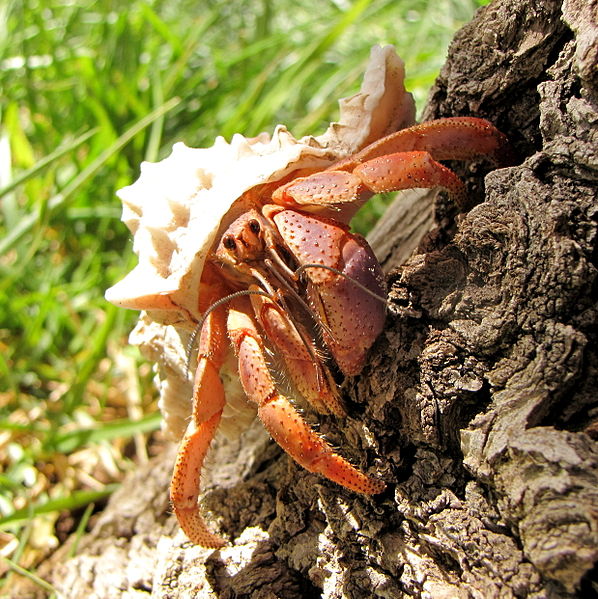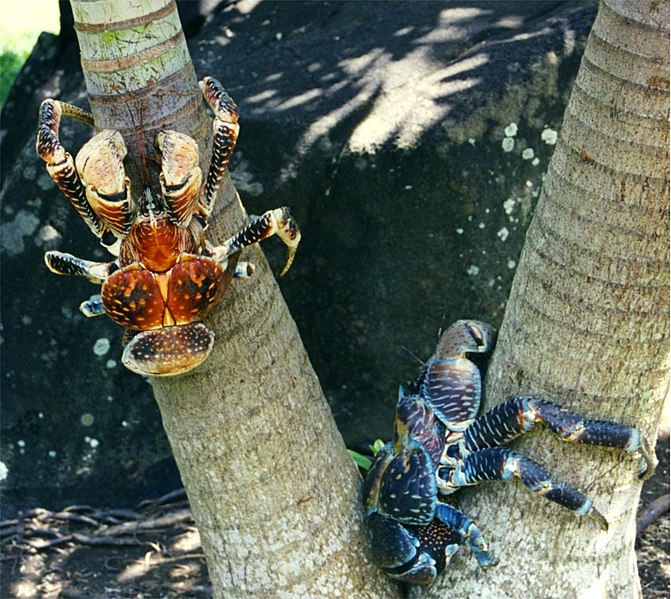
Mating
The species most commonly seen in the pet trade ranges throughout the Caribbean, as far north as Florida and Bermuda. At mating time, both sexes emerge partially from their shells so that the female can receive the male’s sperm on her gonophores – unique organs located on her 4th pair of legs. She then remains on land carrying her fertilized eggs for a month or so before heading to the sea.
In most populations, all gravid (egg-bearing) females march seaward at the same time, resulting in quite a spectacle. This may be an extensive trip, as they have been found living on hills over 3,000 feet high!
Ocean-Going Larvae
Upon reaching the shore, the female Hermit Crabs enter the water and the eggs burst open immediately. The larvae, termed zoea, look nothing at all like crabs. They are invisible to the naked eye, and become part of the plankton, swirling about the sea with billions of other such creatures for 2 months or so. During that time, they go through many changes in appearance and may be carried far away from their hatching site, but most are consumed by other animals.
Those that survive enter the megalopa (final larval) stage. The megalopa live on both land and in shallow water for about 1 month, then molt, take on the adult appearance, and leave the sea for good. Amazingly, most young crabs wind up in the same area where they began life – although how this happens after 2 months at the mercy of ocean currents is difficult to understand.
A Long-Lived Pet, if….
Hermit Crabs are often sold as “trouble-free” pets, but actually they have very specific needs which must be met if they are to live out their 20+ year life spans. At molting time, for instance, the crabs need sea water, a substrate in which they can burrow, and the ability to avoid others lest they be consumed while the new exoskeleton is hardening. Please write in for care details.
A Crustacean Behemoth
 I had the good fortune of caring for the Terrestrial Hermit Crab’s enormous relative, the famed 10-pound-plus Coconut Crab (Birgus latro). Please look for my future article on these largest of all terrestrial invertebrates.
I had the good fortune of caring for the Terrestrial Hermit Crab’s enormous relative, the famed 10-pound-plus Coconut Crab (Birgus latro). Please look for my future article on these largest of all terrestrial invertebrates.
Further Reading
Please see Marine Invertebrates of Bermuda for more natural history and the interesting story of how Hermit Crabs confused scientists studying fossilized shells.
Carribbean Hermit Crab image referenced from wikipedia and originally posted by ZooFari
Coconut Crab image referenced from wikipedia and originally posted by Mila Zinkova
 That Reptile Blog – Reptile, Amphibian and Exotic Pet Care and Information
That Reptile Blog – Reptile, Amphibian and Exotic Pet Care and Information


I’ve always thought that breeding/raising these guys in captivity would be an interesting project. I’ve seen a few scientific papers on larval rearing(from wild collected eggbearing females)to document larval development(culminating with little hermits which took shells if available and emerged and buried in moist sand).
After a lot of searching on hermit crab forums(most people simply say they are too difficult to breed in captivity, period.) I found one case of larvae being deposited in a water bowl in a communal indoor tank. So i believe it could be done. Would be a neat project but I don’t think I have the SW experience/budget/room to do it!
~Joseph
Hello Joseph,
Thanks for the feedback, interesting news about the water bowl; I read one account of a similar situation in a large outdoor pool. Maybe a matter of getting them at the right time – most crabs spawn in tuner with tides, and whole population usually does so at once (true for terrestrial hermits in Bermuda and a few other places that have been studied). Perhaps you’ve seen films of some of the breeding migrations of land crabs on Christmas Island, Cuba – really amazing.
Terrestrial hermits would be an important one to breed due to collecting pressures.
Good luck with all,
Best regards, Frank Indiviglio.
Hello Frank,
I wonder if putting a tank near a window would be enough to expose the crabs to lunar cycles of the moon or whatever external cues they use? But cases I read on mating/eggs in captivity didn’t seem to involve that(but often involved animals kept for a long time or raised from juveniles). It seems that the Ecuadorian hermit(Coenobita compressus) would be the ideal species to attempt to breed…but they are nowhere near as available as the purple pincher C. clypeatus. Are also smaller so maybe not as in demand(I remember playing with them in Costa Rica, on some beaches the debris line on the beach would have numerous little running shells. Yes, we did attempt hermit crab races) I have indeed seen the films of the land crabs…absolutely phenomenal. Was that outdoor pool in FL by any chance?(or otherwise in a warm place possibly in their native range?). I’m assuming the larvae did not survive?(C. compressus, at least, don’t sound overly difficult to raise, I can link you the paper that describes that)
Has any study been done on the impacts of collecting hermits? I think they would be quite vulnerable as they probably do not grow very fast. Actually, what I think might be more damaging is with each hermit crab a shell is removed that lowers the carrying capacity of the habitat it was taken from.
All the Best
~Joseph
Hello Joseph,
Thanks for the feedback. I would like to see the article when you have a chance, I haven’t run across it; I’m not sure about the window, makes sense but not much has been done on that – I’ll try to find the article about the outdoor pond – details escape me right now.
The only study I know of was on Bermuda – casual, but you hit on the point mentioned there – seemed empty shell collecting was the limiting factor, crabs themselves in this case were not taken in large numbers. I’ve also often wondered about the effect of collecting –m have not seen anything in passing re that, they seem common enough in places I’ve been but definitely worth some research, they have been collected for several decades now.
Good luck and please keep me posted.
Best regards, Frank Indiviglio.
http://www.jstor.org/pss/1549576
Not sure if you can read full articles on Jstor. It is available in full length for free on another site. Just search on Google Coenobita compressus larval rearing.
Hello Joseph,
Thanks very much; I’ll check it out and post it here as well so that others might have a look.
Good luck with all, enjoy,
Best regards, Frank Indiviglio.